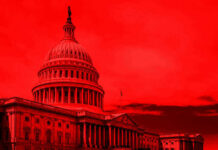
As partisan gridlock plunges Washington into chaos, the 2025 government shutdown exposes the stark reality of a broken budget process—leaving Americans frustrated as vital services grind to a halt and constitutional values hang in the balance.
Story Snapshot
- The federal government shut down at 12:01 a.m. EDT on October 1, 2025, after Congress failed to pass a funding bill.
- This marks the third shutdown during Trump’s presidencies, reflecting deepening political polarization.
- Budget battles center on immigration, welfare spending, and tax cuts, fueling tensions over conservative priorities.
- Millions face furloughs and service delays, while both parties blame each other for the crisis.
Historic Breakdown in Budget Negotiations Threatens American Stability
The U.S. federal government shut its doors at 12:01 a.m. EDT on October 1, 2025, after Congress failed to reach a deal on a budget for the fiscal year.
This critical failure marks the first government shutdown since 2018-2019, also under President Trump’s leadership, and the third such incident during his presidencies.
The breakdown highlights the persistent divisions between lawmakers, whose inability to compromise has directly threatened the functioning of essential government services and the stability that conservative Americans expect from their elected officials.
Key Political Rifts: Immigration and Fiscal Responsibility at the Heart of the Stalemate
Negotiations faltered over competing priorities, with President Trump and Republican leaders demanding fiscal restraint and conservative reforms, particularly on illegal immigration and tax policy.
Democrats pushed back, insisting on welfare payments for undocumented immigrants and reversing GOP tax cuts. The Senate filibuster rule complicated matters further, requiring bipartisan support for any continuing resolution.
As a result, the House passed a funding bill on September 19, but Senate Democrats blocked it, seeking substantial changes to Republican policies. Trump’s attempts to broker a deal with Senate Minority Leader Chuck Schumer and House Minority Leader Hakeem Jeffries ultimately failed, cementing the shutdown.
Immediate Fallout: Service Disruptions and Constitutional Concerns
The shutdown’s impact was swift and severe. Non-essential federal employees were immediately furloughed, and government agencies began executing contingency plans, disrupting services relied upon by millions of Americans.
The Office of Management and Budget ordered agencies to halt operations, affecting everything from healthcare and veterans’ benefits to cybersecurity initiatives.
Conservatives voiced alarm as political brinkmanship threatened not only the smooth operation of government but also constitutional freedoms and family values, with concerns that leftist policies and government overreach were eroding core American principles.
Political Blame Game Fuels Public Frustration
Both parties engaged in a bitter blame game, each accusing the other of sabotaging negotiations. While Republicans cited Democratic obstructionism and reckless spending, Democrats claimed GOP policies endangered social programs and ignored humanitarian concerns.
The shutdown amplified longstanding frustrations among conservative Americans who see government dysfunction as a direct result of failed leftist agendas, globalism, and disregard for fiscal discipline.
The crisis has also heightened scrutiny on government accountability, with many demanding reforms to prevent future shutdowns and restore respect for constitutional limits on federal power.
U.S. government shuts down as Trump and Congress fail to reach a funding deal https://t.co/ivzSsmNpCM
— NBC DFW (@NBCDFW) October 1, 2025
Long-Term Implications: Uncertainty and the Fight for Conservative Values
As the shutdown drags on, uncertainty looms over federal programs, national security, and economic stability. Experts point to the recurring nature of budget impasses as a symptom of deeper structural issues in the U.S. political system—issues that threaten conservative priorities such as limited government, individual liberty, and fiscal responsibility.
For many in Trump’s base, the shutdown is a rallying point to demand a return to common-sense governance and the protection of American values from the excesses of globalist and progressive policies.
The coming weeks will test whether lawmakers can reconcile their differences and end the standoff, or whether the nation will continue to suffer the consequences of partisan gridlock.
Sources:
2025 United States federal government shutdown – Wikipedia
Government Shutdown Clock – White House
Government Shutdown Advisory – Holland & Knight
US Government Shutdown 2025: General Information and Resources for SRCD Members















